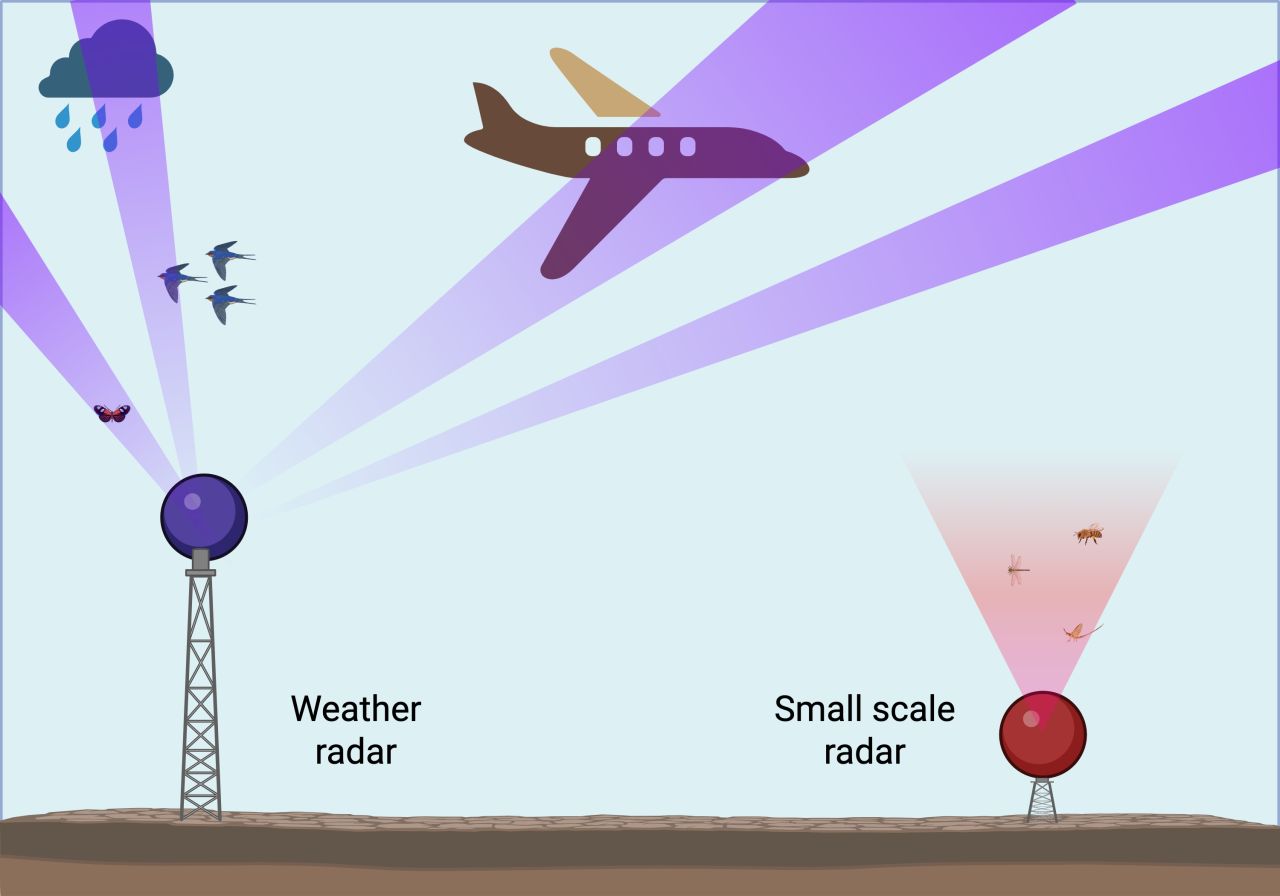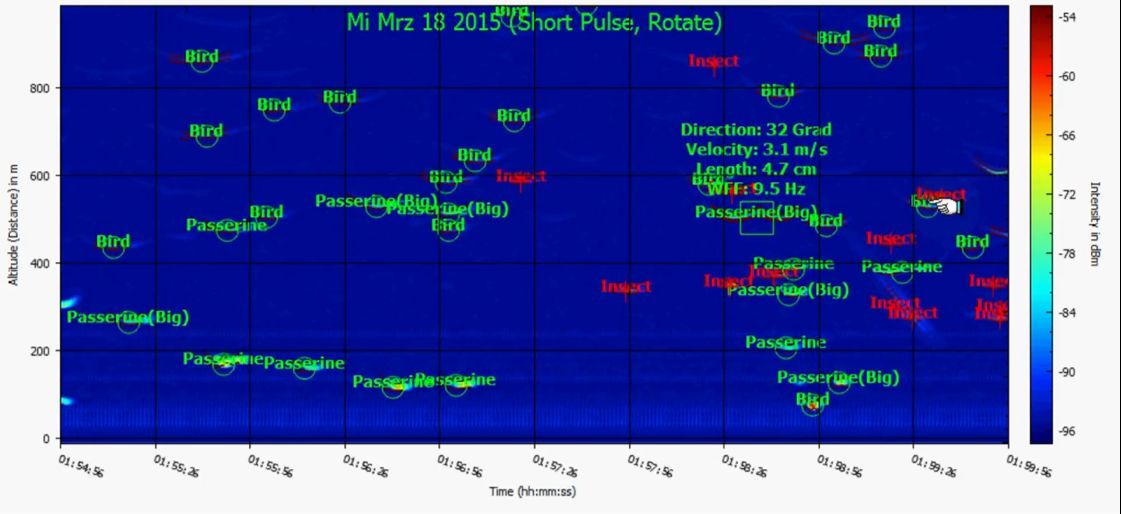Radars for insect monitoring
The sky isn’t empty – it’s alive with millions of insects flying high above. Now, radar technology is revealing their hidden movements, tracking migrations, behaviors, and activity patterns like never before.

Small-scale radars, such as the one above, placed in a farmer’s pasture, are helping scientists monitor the status of insect biodiversity in Switzerland. Image: © Felix Liechti
The hidden world above us
Standing outside on a warm spring day and looking up, you might think there is nothing above you but blue sky. You would be mistaken though; high up in the sky, above our heads, thousands – sometimes millions – of insects are flying. They are flying hundreds of meters in the air, moving between habitats, searching for mates, or even migrating across continents. Although difficult for humans to observe, the airspace is a habitat for insects, just like a forest, a grassland, a stream or a lake.
Traditional insect monitoring falls short
Many insect populations have been undergoing drastic declines due to climate change, habitat loss, and other human-driven factors and processes. Insect numbers and biodiversity are in crisis, but for a long time their declines were hard to measure– simply because insects are small, abundant, and active in places or times where we can’t see them. Monitoring insects in our rapidly changing world remains a major challenge. Traditional methods of observing insects and determining their numbers and diversity – such as light traps, nets, and visual observations – provide only brief snapshots at specific locations and require significant effort. Recently, entomologists have embraced novel technologies to systematically observe insects: radars!
Radars: a powerful new tool
Radars have long been used in meteorology to track weather patterns (e.g. the Meteo Schweiz precipitation radar). But radars can do more than monitor the weather – they detect anything in the air, including birds and insects.
You might think that insects are tiny, and that their movement can’t be very significant – but with millions of them in the sky, their activity really adds up. For example, using radar, scientists estimated that billions of hoverflies migrate between Europe and Great Britain, transporting billions of pollen grains. After arriving in Britain, they help farmers reduce pests on their crops by consuming approximately six trillion aphids (Wotton et al. 2019). A weather radar study in the US showed that mayflies play an important role in moving around key nutrients such as nitrogen and phosphorus (Stepanian et al. 2020).
A major advantage of radar technology is that it allows us to automatically monitor insects over large areas and long periods without the need to capture them. Radars can observe insects in challenging conditions: at night, high in the sky, or in remote regions. Because of these advantages, radars are a promising tool for monitoring insects and understanding how they may be affected by the rapid changes of our current world. To demonstrate this, a group of scientists in Switzerland have launched a new study using radar to estimate how many insects are in the sky and to investigate how land use – such as crops, pastures, and urban areas – affects their biodiversity (learn more about this project at https://hirad.science/about/).
Principle of radar object detection in the air. Radars emit electromagnetic waves in short pulses.When they hit an object – an aircraft, a bird or an insect – they reflect back as an echo. This signal can give information about the object’s distance, size, speed, direction, and other characteristics. Various radar systems use different frequencies of the electromagnetic spectrum and employ different signal processing techniques, depending on their main purpose and specific application field. Video: NOAA
How radars detect insects
Radars operate based on a fairly simple principle: they send out electromagnetic waves, and then “listen” for a response (see image above). When these waves encounter something in the sky (raindrops, insects, planes), they scatter, and some of the reflected energy returns to the "listening" radar. The time it takes to receive this signal can be used to calculate the object's location, and we can even get other types of information, such as the number of insects flying, their size (e.g. butterflies vs. fruit flies), the height they fly at, their speed, and sometimes the frequency with which they beat their wings. Flying animals appear very different on radar than precipitation, and meteorologists are skilled at removing this contamination from the data to make weather forecasts. To aeroecologists, this biological ‘contamination’ is the data, and they take the opposite approach to remove weather and study animal movement.
When people think of radar, they often imagine a weather radar, but many other types exist. For example, airport radars help planes to land safely. While some aeroecologists use weather radars to quantify and track insects, others use specialized small-scale biological radars. Each type has different strengths and weaknesses (Figure 2), which can be leveraged to uncover more about the movement of insects in this habitat which still holds many mysteries to humans.

Two types of radars are currently used to monitor insects – weather radars and specialized small-scale radars. Weather radar: Monitors groups of animals within the scanned airspace, providing information on a cloud of insects or group of birds and their average speed, orientation, and other characteristics. It can cover large areas (tens to hundreds of kilometres distance from the radar and up to 3 km height). Small-scale radar: Provides detailed observations of individual animals and their size, speed, etc. Observes only a narrow range above the radar (some hundreds of meters around the radar and ‘sees’ insects up to ~500m height). Image: © Kaan Mika, created in https://BioRender.com
To view this content, you must accept marketing and third-party cookies.

An example of radar outputs, a program converts the measured objects into Birds, Passerine (smaller birds) and insects. Image: © Swiss Bird Radar Solutions
Although the use of radars for insect monitoring is still developing, researchers have already made remarkable discoveries:
- Quantification of migrating insects: 3.5 trillion insects migrate annually over southern UK.
- Hoverfly migration: 2.6 billion hoverflies cross a 300 km-wide region annually with a biomass of 55.5 tons – exceeding even the biomass of migrating birds.
- Large insect swarms: They show up well on radar and a swarm of 45 million grasshoppers was detected ‘trapped’ in the bright lights of Las Vegas.
- Activity patterns: Insects fly at peak densities at midday, and right after nightfall. These activity patterns are consistent across larger regions.
- High- altitude travel: Insects use wind currents at higher altitudes for efficient travel, achieving migration speeds comparable to birds (1, 2).
We have yet to tap the full potential of radar technology for studying the fascinating world of insects. Many current developments, such as machine learning and artificial intelligence for improved species identification, combination with genetic analysis and camera systems, and citizen science initiatives, promise to revolutionize our understanding of insect movement in the airspace. The sky is not empty – it is alive, and radar is helping us see it.
References
National Oceanic and Atmospheric Administration 2023. How radar works https://www.noaa.gov/jetstream/doppler/how-radar-works Accessed 7.3.2025
Ogier Electronics. How radar Works. https://ogierelectronics.com/technical-articles/how-radar-works/ Accessed 7.3.2025
Gao HU et al. Mass seasonal bioflows of high-flying insect migrants. Science 354;6319:1584-1. https://www.science.org/doi/10.1126/science.aah4379
Wotton KR et al. 2019. Mass Seasonal Migrations of Hoverflies Provide Extensive Pollination and Crop Protection Services. Current biology 29;13:2167-2173.e5. https://doi.org/10.1016/j.cub.2019.05.036
Haes B. et al. 2024. Continental-scale patterns in diel flight timing of high-altitude migratory insects. Philosophical Transactions of the Royal Society B 379;1904. https://doi.org/10.1098/rstb.2023.0116
Chapman JW et al. 2008. Wind Selection and Drift Compensation Optimize Migratory Pathways in a High-Flying Moth. Current Biology 18;7:514-518. https://doi.org/10.1016/j.cub.2008.02.080
Chapman JW et al. 2015. Adaptive strategies in nocturnally migrating insects and songbirds: contrasting responses to wind. Journal of animal ecology 85;1. https://doi.org/10.1111/1365-2656.12420
Stepanian et al 2020. Declines in an abundant aquatic insect, the burrowing mayfly, across major North American waterways, Proc. Natl. Acad. Sci. U.S.A. 117;6:2987-2992,https://doi.org/10.1073/pnas.1913598117 (2020).

